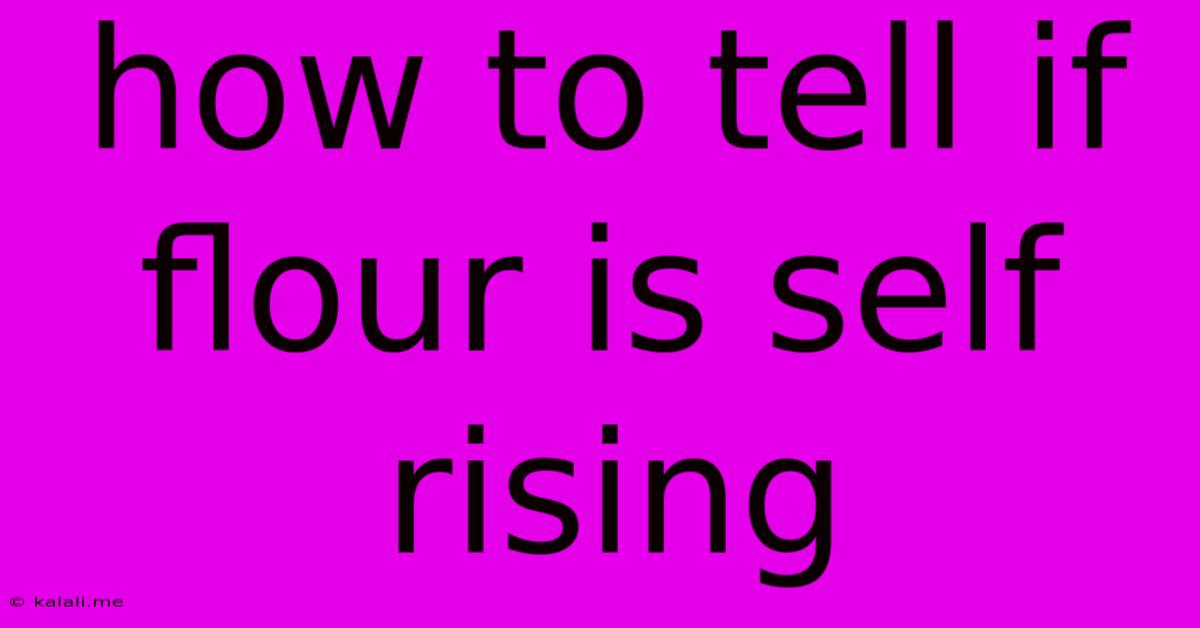How To Tell If Flour Is Self Rising
Kalali
Jun 09, 2025 · 3 min read

Table of Contents
How to Tell if Flour is Self-Rising: A Baker's Guide
So you're ready to bake, but you're staring at a bag of flour and questioning whether it's self-rising or not. This can be a crucial distinction, as using the wrong type of flour can significantly impact the texture and rise of your baked goods. This article will guide you on how to easily identify self-rising flour, and what to do if you're missing this baking essential.
What is Self-Rising Flour?
Self-rising flour is a convenient blend of all-purpose flour, baking powder, and salt. This pre-mixed combination simplifies baking by eliminating the need to measure and add these leavening agents separately. It's a time-saver for recipes that call for a light and airy texture, like biscuits, muffins, and quick breads.
Identifying Self-Rising Flour: The Simple Methods
There are several ways to confirm whether you have self-rising flour:
-
Check the Label: The most straightforward method is to carefully examine the flour bag's label. Self-rising flour will clearly state "self-rising" or "self-raising" on the packaging. Look for this prominent labeling – it leaves no room for guesswork.
-
Ingredient List: If the label is unclear or damaged, check the ingredient list. Self-rising flour will list all-purpose flour, baking powder, and salt as its primary ingredients. The percentages may vary depending on the brand, but all three components must be present.
-
The Visual Test (Less Reliable): While not foolproof, self-rising flour often has a slightly coarser texture than all-purpose flour due to the presence of baking powder. This is a weak indicator, however, and should not be relied upon alone.
What if You Don't Have Self-Rising Flour?
Don't worry if you only have all-purpose flour! You can easily make your own self-rising flour at home. This is a simple substitution that ensures your baking isn't delayed.
Making Your Own Self-Rising Flour:
To make one cup of self-rising flour, you'll need:
- 1 cup all-purpose flour
- 1 1/2 teaspoons baking powder
- 1/4 teaspoon salt
Instructions:
- Whisk: Thoroughly whisk together the all-purpose flour, baking powder, and salt in a medium bowl. Ensure all ingredients are evenly distributed to guarantee consistent leavening.
- Sift (Optional): For a smoother texture, you can sift the mixture through a fine-mesh sieve. This step is not strictly necessary but helps eliminate any clumps.
- Store: Transfer the homemade self-rising flour to an airtight container for future use. Store in a cool, dry place.
Important Note on Baking Powder Freshness: Remember that baking powder loses its effectiveness over time. Check the expiration date on your baking powder before making your self-rising flour. Using old baking powder will result in flat baked goods.
Conclusion:
Determining if you have self-rising flour is simple, mostly relying on careful label reading. However, knowing how to easily make your own self-rising flour empowers you to bake with confidence, regardless of what's in your pantry. Remember always to check the label and use fresh baking powder for best results! Happy baking!
Latest Posts
Latest Posts
-
Why Did Snape Become A Death Eater
Jun 09, 2025
-
What Can I Spray On A Squeaky Belt
Jun 09, 2025
-
How Deep Do You Bury Propane Copper Pipe
Jun 09, 2025
-
Why Do My Lights Flicker In My House
Jun 09, 2025
-
Knocking Pipes When Water Is Not Running
Jun 09, 2025
Related Post
Thank you for visiting our website which covers about How To Tell If Flour Is Self Rising . We hope the information provided has been useful to you. Feel free to contact us if you have any questions or need further assistance. See you next time and don't miss to bookmark.